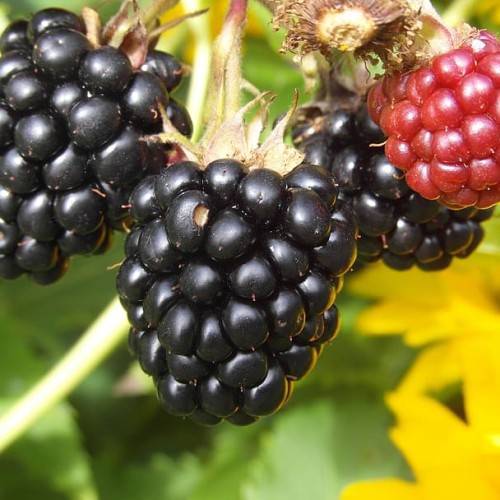
blackberry
Rubus 'APF-236T' BUSHEL AND BERRY BABY CAKES
Cycle:
Perennial
Watering:
Average
Hardiness Zone:
4 - 8
Flowers:
Flowers In Spring
Sun:
full sun
Fruits:
Fruits Ready In Fall
Edible:
Yes
Leaf:
Yes
Growth Rate:
High
Maintenance:
Moderate
Salt Tolerant:
Yes
Care Level:
Medium
watering
Watering a blackberry bush should take place once every 5-7 days, depending on the temperature and sun exposure. For the first 2-3 weeks after planting, the bush should be watered daily to ensure it gets a good start. It is key to keep the soil evenly moist while avoiding over-watering. During the summer months, additional watering may be necessary, especially when days become hot and dry. During the winter months, when the plant is dormant, reduce the amount of waterings to once every 10-14 days. Monitor the soil moisture to ensure it does not dry out entirely throughout the winter.
sunlight
Blackberry plants prefer a minimum of 6-8 hours of direct sunlight a day. If growing in a greenhouse or other enclosed environment with well distributed artificial lighting, aim for 12 hours a day. The blackberry plant needs light intensity strong enough to photosynthesize and bloom to produce flowers and fruits. In areas with cooler temperatures, it is also beneficial to provide supplemental artificial lighting to achieve the ideal light requirements.
pruning
Pruning for the blackberry plant species should take place at the end of winter or very early spring. Pruning should be done in order to encourage vigorous, healthy growth throughout the season. This variety should be pruned up to 30% of its canopy each year in order to improve the quality of its fruits. Pruning should begin with the removal of all diseased or weak canes and then proceed to shaping the bush by removing long weak tips, as well as any unwanted side shoots that are competing for resources. The bush should then be trimmed in order to remove all crossed and overly spindling canes, while also shortening any long shoots when necessary. Pruning should only be done once a year in order to preserve the health and structure of the plant.
